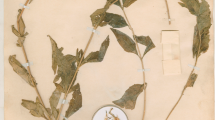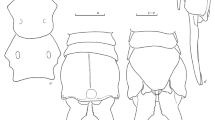Abstract
It is widely recognised that there is no consistent use of the name H. crustuliniforme. The name has been used to represent a number of different taxa and indeed taxa from sections of Hebeloma that are morphologically and molecularly well separated. The holotype of H. crustuliniforme is plate 308 Bulliard from 1787 and while it can be interpreted, no such interpretation can be without ambiguity. It is clear from existing literature that modern authors have applied numerous different interpretations to this name and no real consensus exists. Indeed it appears that at various times most of the medium to large species within both sections Denudata and Velutipes Vesterh. have been referred to as H. crustuliniforme. Within this paper an epitype is selected for H. crustuliniforme in order to give the taxon a precise meaning and a detailed species description is given. Molecular data combined with the results of intercompatibility tests of Aanen and Kuyper published earlier support the definition of H. crustuliniforme adopted in this paper as a distinct taxon and as a biological species. We strongly recommend that this taxon be referred to as Hebeloma crustuliniforme (Bull.) Quél. emend. Vesterh., U. Eberh. & Beker in order to emphasise that it is the specific taxon rather than the complex to which it is being referred.





Similar content being viewed by others
References
Aanen DK (1999) Species and Speciation in the Hebeloma crustuliniforme complex. Ph. D. Thesis, Wageningen Universiteit, Wageningen
Aanen DK, Kuyper TW (1999) Intercompatibility Tests in the Hebeloma crustuliniforme complex in northwestern Europe. Mycologia 91(5):783–795
Aanen DK, Kuyper TW (2004) A comparison of the application of a biological species concept and phonetic species concept in the Hebeloma crustuliniforme complex within a phylogenetic framework. Persoonia 18:285–316
Aanen DK, Kuyper TW, Hoekstra RF (2001) A widely distributed ITS polymorphism within a biological species of the ectomycorrhizal fungus Hebeloma velutipes. Mycol Res 105:284–290
Abarenkov K, Nilsson RH, Larsson K-H, Alexander IJ, Eberhardt U, Erland S, Høiland K, Kjøller R, Larsson E, Pennanen T, Sen R, Taylor AFS, Tedersoo L, Ursing BM, Vrålstad T, Liimatainen K, Peintner U, Kõljalg U (2010) The UNITE database for molecular identification of fungi – recent updates and future perspectives. New Phytol 186:281–285. doi:10.1111/j.1469-8137.2009.03160.x
Boccardo F (2008) Funghi d’Italia. Zanichelli, Bologna
Bon M (2004) Champignons de France et D’Europe occidentale. Flammarion, Paris
Breitenbach J, Kränzlin F (2000) Fungi of Switzerland. 3. Part, 5th edn. Mykologia, Luzern
Bulliard P (1787) Herbier de la France; ou, Collection complette des plantes indigenes de ce royaume; avec leurs propriétés, et leurs usages en medecine, vol 7. Bulliard, Didot, Debure, and Belin, Paris
Bulliard P (1792) Herbier de la France; ou, Collection complette des plantes indigenes de ce royaume; avec leurs propriétés, et leurs usages en medecine, vol 12. Bulliard, Didot, Debure, and Belin, Paris
Cetto B (1976) I Funghi dal Vero, vol 2. Arti Grafiche Saturnia, Trento
Courtecuisse R, Duhem B (1995) Mushrooms and Toadstools of Britain & Europe. Collins, London
Dähncke RM (1993) 1200 Pilze in Farbfotos. AT, Aarau, Switzerland
Eberhardt U, Beker HJ, Vesterholt J, Dukik K, Walther G, Vila J, Fernández Brime S (2013) European Species of Hebeloma Section Theobromina. Fungal Divers 58:103–126. doi:10.1007/s13225-012-0188-3
Gerhardt E (2003) Pilze. BLV, Munich
Grilli E (2007) Type Studies in Hebeloma unravelling a taxonomic-nomenclatural tangle: What is Hebeloma leucosarx? Micologia e Vegetazione Mediterr 22:133–176
Katoh K, Standley DM (2013) MAFFT Multiple Sequence Alignment Software Version 7: Improvements in Performance and Usability. Mol Biol Evol. doi:10.1093/molbev/mst010
Katoh K, Misawa K, Kuma M, Miyata T (2002) MAFFT: a novel method for rapid multiple sequence alignment based on fast Fourier transform. Nucleic Acids Res 30:3059–3066. doi:10.1093/nar/gkf436
Kauff F, Lutzoni F (2002) Phylogeny of the Gyalectales and Ostropales (Ascomycota, Fungi): among and within order relationships based on nuclear ribosomal RNA small and large subunits. Mol Phylogenet Evol 25:138–156
Knudsen H (2003) Politikens Svampebog. Politiken, Copenhagen
Kõljalg UR, Nilsson H, Abarenkov K ,Tedersoo L, Taylor AFS, Bahram M, Bates ST, Bruns TD, Bengtsson-Palme J, Callaghan TM, Douglas B, Drenkhan T, Eberhardt U, Dueñas M, Grebenc T, Griffith GW, Hartmann M, Kirk PM, Kohout P, Larsson E, Lindahl BD, Lücking R, Martín PM, Matheny BP, Nguyen NH, Niskanen T, Kabir J, Peay OG, Peintner U, Peterson M, Põldmaa K, Saag L, Saar I, Schüßler A, Scott JA, Senés C, Smith ME, Suija A, Taylor DL, Telleria T, Weiß M, Larsson K-H (accepted, online) Towards a unified paradigm for sequence-based identification of Fungi. Molecular Ecology. doi:10.1111/mec.12481
Maddison WP, Maddison DR (2011) Mesquite: A modular system for evolutionary analysis, v. 2.75. http://mesquiteproject.org
Marmeisse R, Gryta H, Jargeat P, Fraissinet-Tachet L, Gay G, Debaud J-C (1999) Ectomycorrhizal fungi: Key genera in profile: Hebeloma. In. pp 89–127
McNeill J, Barrie WR, Buck V, Demoulin V, Greuter W, Hawksworth DL, Herendeen PS, Knapp S, Marhold J, Prado J, Prud’Homme van Reine WF, Smith GF, Wiersema JH, al. e (2012) International Code of Nomenclature for algae, fungi and plants (Melbourne Code). Regnum Vegetabile
Miller MA, Pfeiffer W, Schwartz T (2010) Creating the CIPRES Science Gateway for inference of large phylogenetic trees. In: Proceedings of the Gateway Computing Environments Workshop (GCE), 14 Nov. 2010, New Orleans, LA pp 1–8. doi:10.1109/GCE.2010.5676129
Moser M, Jülich W (1998) Colour Atlas of Basidiomycetes: III Agaricales Hebeloma (Fr.) Kummer, vol 3. Gustav Fischer Verlag, Stuttgart
Rambaut A (2012) FigTree. Tree figure drawing tool, v. 1.4.0. http://tree.bio.ed.ac.uk/
Ryman S, Holmasen I (1992) Svampar. En fälthandbok. Interpublishing, Stockholm
Schmitt I, Crespo, Divakar APK, Fankhauser JD, Herman-Sackett E, Kalb K, Nelsen MP, Nelson NAE, R-P E, Shimp AD, Widhelm T, Lumbsch HT (2009) New primers for promising single-copy genes in fungal phylogenetics and systematics. Persoonia 23:35–40. doi:10.3767/003158509X470602
Stamatakis A (2006) RAxML-VI-HPC: maximum likelihood-based phylogenetic analyses with thousands of taxa and mixed models. Bioinformatics 22:2688–2690. doi:10.1093/bioinformatics/btl446
Stamatakis A, Hoover P, Rougemont J (2008) A rapid bootstrap algorithm for the RAxML web servers. Systematic Biol 57:758–771. doi:10.1080/10635150802429642
Swofford DL (2002) PAUP*: phylogenetic analysis using parsimony (*and other methods). Version 4. Sinauer Associates, Sunderland
Vesterholt J (2005) The Genus Hebeloma, vol 3. Fungi of Northern Europe, Tilst
Acknowledgments
We are very much obliged to L. Gosling who made the distribution map for this and previous publications and to G. Walther for providing the microscopic line drawings. The authors would like to thank the herbaria in C (Copenhagen), GLM (Görlitz), IB (Innsbruck), K (Kew), L (Leiden), LY (Lyon), PDD (Auckland) for the loan of collections for study and sequencing, T. Kuyper for making material available from D. Aanen’s collections from WBS (Biologisch Station Wijster, Wageningen University) and BR (Meise) for kindly managing the deposits. Furthermore, we very much appreciate the help of M.L. Beker, P. Boisen Hansen, G. Corriol, C. Hobart, J. Horman, S. Kelly, P. Leonard, M. Loizides, P.-A. Moreau, P. Jargeat, T. Tokov and an anonymous collector for supplying us with interesting and exciting Hebeloma collections. We would also thank P. Kirk for providing us with statistics from the Fungal Records Database of Britain and Ireland. Numerous people have helped in the lab to generate Hebeloma sequence data that were used directly or indirectly in this study. We would like to thank K. Dukik, U. Fürst, R. Gadjieva, S. Garnica, M. Jonsson, C. Lundström, J. Petterson, D. Öncü and J. Schade as well as the Uppsala University Genome Center and the Hubrecht Institute sequence facility.
Author information
Authors and Affiliations
Corresponding author
Additional information
Jan Vesterholt Deceased.
Electronic supplementary material
Below is the link to the electronic supplementary material.
ESM 1
(PDF 326 kb)
Rights and permissions
About this article
Cite this article
Vesterholt, J., Eberhardt, U. & Beker, H.J. Epitypification of Hebeloma crustuliniforme . Mycol Progress 13, 553–562 (2014). https://doi.org/10.1007/s11557-013-0938-y
Received:
Revised:
Accepted:
Published:
Issue Date:
DOI: https://doi.org/10.1007/s11557-013-0938-y




